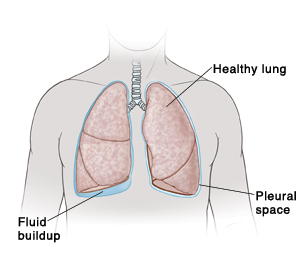Understanding Pleural Effusion
Your healthcare provider has told you that you have a pleural effusion. The pleura are 2 thin layers of smooth tissue around the lungs and lining the chest. Pleural effusion means that you have extra fluid between the pleura. This area is called the pleural space. The pleural space normally holds only a small amount of fluid. This fluid lubricates the pleura. But if too much fluid fills the space, it can make it hard or painful to breathe.
There are 2 types of pleural effusion:
-
Exudative. This is caused by extra fluid related to inflammation, injury, infection, or a tumor. Empyema is when pus builds up in the pleural space.
-
Transudative. This is caused by abnormal fluid pressure inside the blood vessels. The pressure can be caused by congestive heart failure (CHF). In CHF, extra fluid collects inside the lung tissues because of a weak heart muscle. This extra fluid then leaks into the pleural space. Other causes include kidney disease, liver disease, and malnutrition.
 |
| Pleural effusion is fluid buildup between the layers of tissue that line the outside of the lungs. |
What are the symptoms of pleural effusion?
Many people don't have symptoms. But the most common symptoms of either type of pleural effusion include:
-
Sharp pains in the chest, especially when taking a breath, coughing, or sneezing
-
Shortness of breath or trouble breathing
-
Cough
-
Fever
-
Extreme tiredness (fatigue)
What causes pleural effusion?
Causes include:
-
Pneumonia or other lung infection
-
Heart failure
-
Liver disease (cirrhosis)
-
Tumor
-
Chest injury
-
Lupus
-
Kidney failure or peritoneal dialysis
-
Nephrotic syndrome
-
Pancreatitis
-
Rheumatoid arthritis
-
Tuberculosis
-
Viral lung infection
-
Cancer
-
Blood clot in the lung (pulmonary embolism)
-
Heart surgery
-
Medicine reactions
How is pleural effusion diagnosed?
Your healthcare provider will examine you and ask about your symptoms and your health history. Tests include:
-
Blood tests
-
Analysis of fluid in pleural space
-
Chest X-ray, CT angiography, or ultrasound
-
Thoracoscopy
How is pleural effusion treated?
The extra fluid may be drained from the pleural space. This is done with a procedure called thoracentesis. A thin needle is used to draw out the fluid from the pleural space. In some cases, a chest tube is placed to drain the extra fluid. The tube will likely stay in place for a few days.
You may have other treatments, depending on the cause of your pleural effusion. If it’s due to a bacterial infection, you will be given antibiotics to fight the infection. If it’s caused by a heart condition, you will be given medicines and other treatment for your heart. Your healthcare provider can tell you more about the cause of your pleural effusion and your treatment options.
What are the long-term concerns?
If untreated, pleural effusion can lead to serious health problems. These include a collapsed lung from fluid filling the pleural space.
Call 911
Call 911 if you have:
When to call your healthcare provider
Call your healthcare provider right away if you have:
-
Continued coughing
-
Fever of 100.4°F (38.0°C) or higher, or as directed by your provider
-
New symptoms or symptoms that get worse
Online Medical Reviewer:
Heather M Trevino BSN RNC
Online Medical Reviewer:
Marianne Fraser MSN RN
Online Medical Reviewer:
Sravani Chintapalli
Date Last Reviewed:
4/1/2024
© 2000-2025 The StayWell Company, LLC. All rights reserved. This information is not intended as a substitute for professional medical care. Always follow your healthcare professional's instructions.